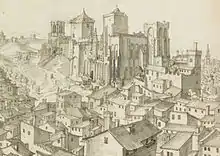Avignon Cathedral
Avignon Cathedral (French: Cathédrale Notre-Dame des Doms d'Avignon) is a Roman Catholic church located next to the Palais des Papes in Avignon, France. The cathedral is the seat of the Archbishop of Avignon.
| Cathedral of Our Lady of Doms Cathédrale Notre-Dame des Doms d'Avignon | |
|---|---|
 Avignon Cathedral | |
| Religion | |
| Affiliation | Roman Catholic Church |
| District | Archdiocese of Avignon |
| Rite | Roman |
| Ecclesiastical or organizational status | Cathedral |
| Location | |
| Location | Avignon, France |
| Geographic coordinates | 43°57′06″N 4°48′27″E |
| Architecture | |
| Type | Church |
| Style | Romanesque, Gothic |
| Groundbreaking | 12th century |
| Completed | 1425 |
| Official name: Historic Centre of Avignon: Papal Palace, Episcopal Ensemble and Avignon Bridge | |
| Type | Cultural |
| Criteria | i, ii, iv |
| Designated | 1995 |
| Reference no. | 228 |
| State Party | |
| Website | |
| Official Website | |

The cathedral is a Romanesque building, constructed primarily in the second half of the 12th century.[1] The bell tower collapsed in 1405 and was rebuilt in 1425. In 1670–1672 the apse was rebuilt and extended.[2] This led to the destruction of the medieval cloister.[3]
The building was abandoned and allowed to deteriorate during the Revolution, but it was reconsecrated in 1822 and restored by the archbishop Célestin Dupont in 1835–1842.[4] The most prominent feature of the cathedral is a gilded statue of the Virgin Mary atop the bell tower which was erected in 1859.[4] The interior contains many works of art. The most famous of these is the mausoleum of Pope John XXII (died 1334), a 14th-century Gothic edifice. It was moved in 1759, damaged during the Revolution, and restored to its original position in 1840.[5] The cathedral was listed as a Monument historique in 1840.[6] In 1995, the cathedral, along with the Palais des Papes and other historic buildings in the Avignon city center, became a UNESCO World Heritage Site because of its outstanding architecture and its importance during the 14th and 15th centuries.[3]
References
- Girard 1958, p. 162.
- Girard 1958, pp. 163, 166.
- "Historic Centre of Avignon: Papal Palace, Episcopal Ensemble and Avignon Bridge". UNESCO World Heritage Centre. United Nations Educational, Scientific, and Cultural Organization. Retrieved 20 October 2021.
- Girard 1958, p. 163.
- Girard 1958, p. 165.
- Base Mérimée: Cathédrale Notre-Dame-des-Doms, Ministère français de la Culture. (in French)
Sources
Further reading
- Labande, L.-H. (1906). "L'église Notre-Dame-des-Doms, Avignon: des origines aux XIIIe siècle". Bulletin archéologique du Comité des travaux historiques et scientifiques (in French). Paris: Imprimerie Nationale. pp. 282–365.
- Labande, L.-H. (1910). "Cathédrale Notre-Dame-des-Doms". Congrès archéologique de France: LXXVIe session tenue à Avignon en 1909 par la Société française pour la conservation des monuments historiques (in French). Vol. 1. Paris: A. Picard. pp. 7–17.
- Rouquette, Jean-Maurice (1974). Provence Romane: La Provence Rhodanienne (in French, English, and German). Paris: Zodiaque. pp. 205–218. OCLC 1036957.
